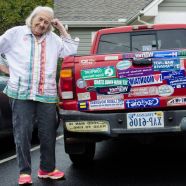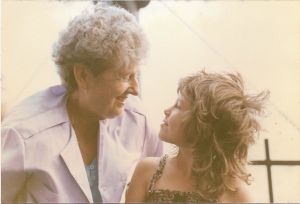Helen Lewis and Community Building in Appalachia
Helen Lewis has many honorifics, including Doctors of Divinity and Sociology and Grandmother of the Appalachian Studies movement. She has many laurels on which she could rest if she were so inclined (she’s not). She’s been part of the work of many of the Appalachia’s and the South’s most significant movements and institutions, including the Highlander Research and Education Center and Appalshop, a media, arts, and education center in Whitesburg, Kentucky. Helen has cooked and poured drinks and taught in prisons and gone to jail for civil rights and stood on picket lines and raised up stories and drawn out fierceness and planted gardens and freed herself and worked for others’ liberation.
In my life, she has been a present and active presence since I was born into the gentle, radical community she helped form and sustain on the banks of the Clinch River in southwest Virginia. She was my neighbor and friend growing up. As a young child, I was pretty sure she was a witch—a good one. She had a cow skull hanging at her front gate and shelves of dried herbs to brew tea. She had a black cat and a captivating stream of visitors and records to dance to—her home captured the sense that the power and potency of a life lived in service of justice was a life of strength and magic.
The good witch I adored is and was a tremendous force in the world beyond that river farm. She spent a lifetime as a radical educator and activist, working from the Deep South to Appalachia on race, class, and gender justice issues from the 1940s to now. Joining the YWCA while at Georgia State College for Women (where she edited the yearbook with Flannery O’Connor), she got involved in civil rights activism in Georgia and was arrested for participating in an integrated public organizing meeting. From those early radicalizing moments, she launched decades of movement building, change making, and community organizing.
Any home Helen has ever lived in has been rich with the artifacts of her work and travels: a Mother Jones poster declaring from the wall, “There is never peace in West Virginia because there is never justice”; paintings of the coal tipples and coke ovens of her life in the southwest Virginia coalfields; photos of women on picket lines in Wales and Harlan County, Kentucky; a patchwork hanging that reads, “I shall not grow conservative with age”; and a foot-high replica of Michelangelo’s David, which has jauntily dominated the bathroom sink landscape of Helen’s homes for decades.
In 2003, a few months following the death of my grandfather, my grandmother and I went to visit our friend Helen at her home in north Georgia. Helen is many things to many people—an activist, educator, rabble rouser, cook, guide—and to us that week she was the provider of nurturing comfort of long friendship after deep loss. I ended that week knowing how to cook her squash casserole, saw glimpses of a raucous past shared between these two old friends, and concluded with a pivotal moment in my life—Helen called me a colleague. Years later, and a few weeks ago, in the midst of major life changes of my own, Helen’s advice was, in essence, to follow her lead. To set a course of your own instead of tracking along the needs or directives of others. To have your own work and your own purpose clear in mind. To see what needs done and do it.
It feels impossible to convey the potency of Helen’s work. The scope. She has never, ever stopped working for justice. Never stopped seeking community. Never stopped bringing people together. At ninety-two she is still organizing, writing, shaping radical worship services, feeding people, building coalitions, and participating in civic, academic, and community life. She’s not daunted by the physical limitations of age; she’s pissed about them. Helen’s fire is matched only by her analysis and understanding of how to build community and why community is important in the fight for social justice. She’s written extensively of her work in this realm and has condensed some of her lessons into a twelve-step guide for community building (the abridged version shared here is from her book Helen Matthews Lewis: Living Social Justice in Appalachia, edited by Patricia Beaver and Judith Jennings [University of Kentucky Press, 2012]).
Rebuilding Communities: A Twelve-Step Recovery Program
1. Understand your history—share memories. As communities regain their histories, they also develop an understanding of the community’s role in the larger history of region, nation, and world.
2. Mobilize/organize/revive community. You need unifying events. Meetings, reunions, festivals, parades, discussions, study groups, and celebrations are ways to make community building fun. Music, dancing, and food bring people together and revive the spirit.
3. Profile and assess your local community. Survey and map community resources and needs. Catalog “people resources”: skills, gifts, talents, and local expertise. Survey land resources: water, soil, timber, minerals, and beauty. Draw on the resources rather than emphasizing the deficiencies.
4. Analyze and envision alternatives. Determine what the community wants to preserve and to change. Visit other communities, look for models, alternatives, new ways of development, and analyze strategies for change.
5. Educate the community. Personal transformation and community transformation should occur together. The process of education allows a community to develop understanding, which can be used to plan, control, and monitor change.
6. Build confidence and pride. Regaining community history through oral histories, music, and theater helps build identity and pride.
7. Develop local projects. As the group begins a planning process, they can link needs and resources and develop projects to bring them together and involve new and different groups in the community.
8. Strengthen your organization. Leadership development and staff training are important. . . . Everyone needs to be involved in strategic planning and evaluation.
9. Collaborate and build coalitions. Community groups need to make linkages and form networks and partnerships with other groups to gain strength, share resources, and learn from each other’s efforts, successes, and failures.
10. Take political power. Political activity becomes essential to challenge and change policies to redirect resources to the community. Civic education, voter registration, local monitoring projects, attending civic and governmental meetings, electing community members to boards are all strategies for building political power.
11. Initiate economic activity. Community groups can encourage and begin development of home-grown businesses. Seek capital for local projects and work with local banks to invest in community businesses.
12. Enter local/regional/national/international planning processes. Communities must recognize that they are part of a regional, national, and international economy, so they need to understand how the global economy impacts the local economy. Be part of an international movement to build a moral, just economy.
I have been blessed to be part of many of the communities Helen has helped build and sustain. In 2012, my mother and I wrote a joint reflection of the ways Helen has influenced our lives that was included in her book, Helen Lewis: Living Social Justice in Appalachia.
“She has taught us that simple, sustaining joys like cooking and gardening and good conversation are the foundation that holds up the work of radical activism. She showed us that radical activism itself takes many forms, and plays out on many arcs of time. She helped us see that Appalachia is a home worth fighting for. With Helen, there is always another project, another story, another piece of work on the horizon or around the corner. She helps us remember that building and sustaining intersecting commitments to each other, to place, to culture, and to justice is the most important work we can do.”
There are generations of women and communities whose lives have benefited from Helen’s steady, visionary, practical, powerful work. Of the many titles Helen bears, I’m tempted to add priestess. She would laugh at that, but in trying to convince her, I’d point out the rituals and rites of her life’s work—the creation of sacraments in the everyday lives of those around her—pouring libations, giving succor, lifting up voices in praise of justice and equality, giving guidance to those wondering how best to create the change they wish to see. Helen may shake her head at that, and then she’ll be on to the next project, encouraging us to get back to work. There are things that need done.









And tonight (Feb. 22nd) Helen had a friend drive her on a 120 mile round trip to Big Stone Gap, VA to join over a hundred people in a public forum on the Affordable Care Act. And of course she shared a meal with us afterwards.
Thank You Amelia, what a wonderful reflection of an amazing woman’s life.
Thanks. I first met Helen in the mid 80’s. I was going on about not being sure what lay ahead of me, grad school or work. I can still see Helen sipping on her bourbon and letting me know that school was always there and that if I had work I needed to do then do it….
I met Helen in the summer of ’88, when she was on the faculty of the Appalachian Ministry Resource Center. Over the years I’ve visited her at the River Farm in Virginia, at conferences in VA and DC, at the Highlander Center and just last summer at her new community, Elderspirit, in Abingdon, VA. She is one of the most amazing and inspiring people I’ve ever known!
Thank you Amelia.
So true and so beautifully expressed.
Bravo to each of you.
Amelia,
What an inspired tribute to Helen born out of love that we all share and feel for her. A true legend has passed. Thank you for this.
Elise
Amelia,
What a wonderful piece that captures the true essence of who Helen is and what she has accomplished. Thanks for this.
Amelia,
What a wonderful piece. You capture so well the essence of who Helen is and what she has accomplished. Thanks for doing it.
Thanks, Amelia, for this inspiring profile. Helen Lewis truly is remarkable. And so are you.
Wonderful reading about a teacher and mentor who touched my life. Busy, dictated and one of the most interesting person you’ll ever meet she is also great fun. Thank you Amelia, and; Thank you Helen Lewis, I love you.
I just heard today that Helen died Helen died on September 4th, 2022, at 9:15pm from complications after COVID. She will be buried at the River Farm on Thursday September 8th at 2pm. Memorial Services will follow at another time. Helen was 97 years old.
Beautiful tribute !
Thanks Amelia. I taught a course on App Health in ‘70 or ‘71 at Clinch Valley-drove from Harlan. Helen was an exceptional person.
Oh my Amelia. What a wonderful tribute and so well delivered. She and her paths will be long remembered and contemplated.